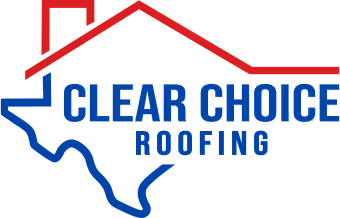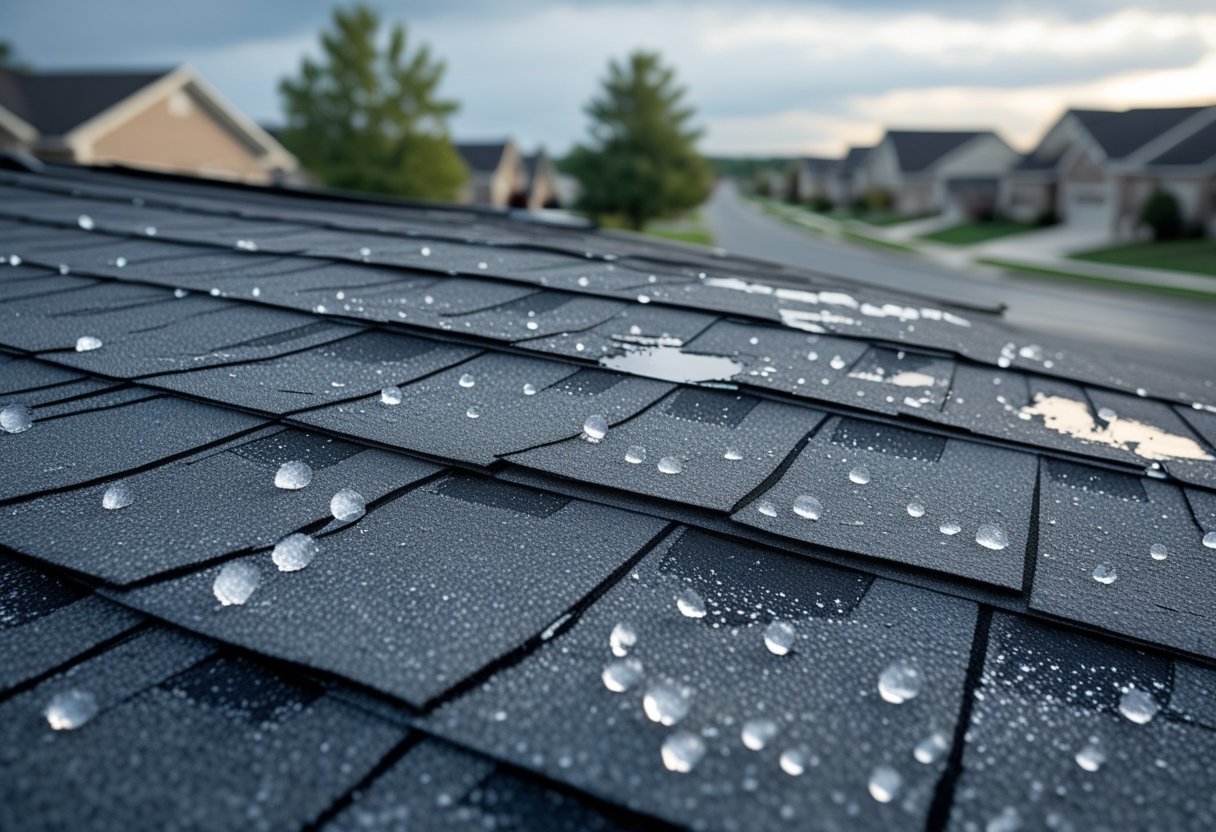Hail damage can shorten your roof’s lifespan by causing small cracks, dents, and loss of protective granules. These damages let water seep in, which can lead to leaks and more serious problems over time.
Your roof won’t last as long as it should if you ignore hail damage. You could face expensive repairs if you don’t address the problem early.
You might not always see hail damage right away. Regular checks after storms help you catch problems early.
Knowing what to look for means you can protect your home and avoid bigger issues in the future.
Understanding Hail Damage On Roofs
Hail can cause different types of damage to your roof. Knowing what kind of damage happens, which materials get hurt most, and how hail forms can help you protect your home better.
Types of Hail Damage
Hail can create dents, cracks, or even holes in roofing materials. You might see damage to shingles, such as granule loss or cracking.
Metal roofs can get dents or punctures, which weaken their protection. Gutters, vents, and downspouts may also be dented or bent.
Even small hail, about one inch or larger, can cause significant dents. Left unchecked, these damages can lead to leaks or faster roof wear.
Common Roof Materials Affected
Asphalt shingles often lose protective granules, reducing their lifespan. Cracks and splits are common after hail hits.
Metal roofs can dent and rust if the protective layer is damaged. This reduces their durability.
Other materials like wood shake or tile can crack or break on impact. Inspect these roofs carefully to find hidden damage.
How Hail Forms and Strikes Roofs
Hail forms during thunderstorms when wind cycles raindrops up and down in cold clouds. Layers of ice build until the hail falls.
The size of hail depends on storm strength. Larger hail causes more roof damage.
Hail hits your roof hard and fast, mostly affecting elevated parts like ridges and vents. Wind can blow hail at different angles, increasing damage spots.
How Hail Damage Reduces Roof Lifespan
Hail can cause damage that affects how long your roof lasts. Some damage happens right away, while other problems develop slowly over time.
These issues can let water in and weaken the roof’s structure, cutting its useful life short.
Immediate vs. Long-Term Effects
When hail hits your roof, you’ll notice dents or cracks. These marks might seem small, but they show where the roof has been weakened.
Larger hailstones, usually those over one inch, can cause more serious dents or even break shingles. Over time, hail damage can get worse.
Small cracks can grow bigger, and damaged shingles lose their protective granules. This lets water and debris get under the roofing material, causing more harm.
Impaired Water Resistance
Your roof is designed to keep water out. When hail hits, it can create holes or cracks in the material.
This damage reduces the roof’s ability to repel water and keep your home dry. Once water gets inside, it can cause leaks and damage to the wood underneath.
Wet wood can rot and weaken, risking leaks into your home. If you see granule loss or dents in shingles, your roof may not be protecting you as well as it should.
Structural Weakness Over Time
Repeated hail impacts wear down even strong roofing materials like metal or asphalt shingles. The surface protection gets chipped or cracked over time, lowering the roof’s durability.
Damaged shingles let in moisture, leading to mold or wood decay. These hidden problems make your roof less safe and less effective.
Recognizing Signs Of Hail Damage
Hail can leave different types of damage on your roof, some easy to spot and others hidden. Knowing what to look for helps you catch problems early before they shorten your roof’s life or cause expensive repairs.
Visible Surface Issues
Look closely at your shingles for dents or cracks. You may notice missing granules, which look like bald spots on the shingles.
These granules protect your roof from the sun and help prevent leaks. Check metal parts like vents, gutters, and downspouts too.
Hail can leave dents or bends that reduce their effectiveness. Dark spots or black marks on your shingles can also show where hail struck.
Take photos of any damage for insurance purposes.
Hidden Damage Indicators
Some damage won’t show on the roof’s surface. Check inside your home for signs like water stains on ceilings or walls.
These could mean your roof is leaking. Look for granule loss in gutters or near downspouts, as this often points to bigger problems in the roofing material itself.
Sometimes shingles look okay but may be weaker where they were hit.
Inspection Tips After a Hailstorm
Don’t climb on your roof unless you’re trained. Use binoculars or take pictures from the ground to spot damage.
After a big hailstorm, contact a professional roofer for a detailed inspection. They can find hidden issues and help with insurance claims.
Keep a checklist like this handy:
- Dents or cracks on shingles
- Missing or loose granules
- Bent or dented metal parts
- Inside leaks or water marks
Preventing And Minimizing Hail Damage
Protecting your roof from hail means taking steps to keep it strong, choosing the right materials, and preparing for seasons when hail is more common. These actions help you avoid big repair bills and extend your roof’s life.
Maintenance For Better Protection
Keeping your roof in good shape helps it resist hail damage better. Look for loose or missing shingles and fix them quickly to avoid weak spots.
Clean gutters and downspouts often to prevent water buildup that can worsen damage. Regular inspections are key.
Check your roof after storms and at least twice a year. Small dents or cracks can get worse if left alone.
Fixing problems early saves money and keeps your roof working longer.
Impact-Resistant Materials
Using impact-resistant shingles or metal roofing makes a big difference. These materials handle hail better than regular options.
They reduce dents, cracks, and other damage, helping your roof last longer. Brands like Owens Corning offer shingles rated for impact resistance.
These products come with stronger warranties too. While they may cost more up front, they often save you from costly repairs later.
Seasonal Preparedness
Know when hail is most likely to hit your area and get your roof ready ahead of time. For example, in Texas, spring and early summer bring more hailstorms.
Check your roof before these seasons and fix any weak spots. Protect your outdoor items and clear debris that might get blown on or against your roof during storms.
Have your insurance info and roofing company contacts handy for quick response if damage happens.
At Clear Choice Roofing, we are here to help you protect your home with expert advice and quality materials. Call us anytime for an inspection or repair!
Repair Options And When To Replace Your Roof
Knowing your repair options and when it’s time to replace your roof can save you money and keep your home safe. It’s important to get a clear idea of the damage and work with the right contractor to get quality results.
Professional Roof Assessments
A professional roof assessment is the first step after hail damage. A trained roofer will check for dents, cracks, missing shingles, and leaks that you might not see.
They know how to spot hidden damage that can cause bigger problems later. During the inspection, they will assess whether repairs can fix the damage or if the roof’s condition is beyond repair.
This evaluation includes checking the roof’s structure, warranties, and how much life is left in your roof. Getting an accurate, detailed report helps you make smart decisions and can support insurance claims.
Repair Versus Replacement Decision
If the damage is limited to a few shingles or small dents, repairs can extend your roof’s life. Repairs are usually faster and cost less than a full replacement.
Simple fixes include patching leaks, replacing damaged shingles, or sealing cracks. If the hail has caused widespread damage—like multiple missing shingles, dents in metal roofing, or damaged underlayment—a replacement might be necessary.
Replacement is best when repairs won’t protect your home from leaks or reduce risks of future damage.
Use this guide to decide:
ConditionBest OptionNotes Minor dents and isolated shingle damageRepairInspect yearly to watch repairsMultiple missing or broken shingles, large leaksReplacementPrevents long-term water damageDamage to roof structure or underlaymentReplacementCritical for safety and durability
Choosing The Right Contractor
Hiring the right contractor is key to a successful repair or replacement. Look for a local company with solid experience in your area’s weather conditions.
Make sure they inspect the roof thoroughly and explain your options clearly. Check reviews and ask if they handle insurance claims to ease your process.
A trustworthy roofer uses good materials and follows proper installation methods. At Clear Choice Roofing, you get honest advice and expert work.
We provide free estimates and help with insurance paperwork. Choosing a certified contractor like Clear Choice means you’ll get a durable roof and peace of mind.
Insurance And Warranty Considerations
Protecting your roof after hail damage involves understanding how insurance and warranties work. Knowing how to file claims, what your policy covers, and the limits of your warranty can save you time and money.
Filing Insurance Claims
When hail damages your roof, file a claim with your insurance company quickly. Take clear photos of the damage and keep records of all communication.
Your insurer will usually send an adjuster to inspect the roof. Be honest and detailed when describing the damage.
Delays or missing info can slow down your claim approval. Some policies cover only repairs while others cover full replacement if the damage is severe.
You can also get help from roofing experts to guide you through the claim process and understand the paperwork.
Understanding Policy Coverage
Insurance policies vary widely on hail damage coverage. Most homeowner policies cover hail, but limits on payout amounts, deductibles, and depreciation might reduce what you get.
Check if your policy covers:
- Full roof replacement
- Only repairs
- Impact-resistant materials upgrade
- Additional living expenses if your home is unlivable
Understanding your policy ahead of time helps you avoid surprises during a claim. If your coverage is unclear, ask your insurer for a detailed explanation.
Warranty Limitations After Hail
Most roofing warranties don’t cover hail damage, especially if the damage is caused by severe weather. Warranties generally cover defects in materials or workmanship, not sudden accidents.
Even with a strong warranty, hail can void coverage if it causes cracks, dents, or missing shingles. However, choosing impact-resistant roofing materials can sometimes extend warranty protection.
If you have a warranty, check the fine print about weather damage and keep your service receipts. Some contractors, like Clear Choice Roofing, offer extended warranties and support even after hail damage, giving you extra peace of mind.
Long-Term Solutions For Roof Longevity
Hail damage can weaken your roof over time. Regular inspections are key to making your roof last longer.
Check your roof twice a year, especially after storms. Early checks help you catch problems before they get worse.
Use high-quality materials for your roof. Metal or tile roofs can last 50 to 70 years if you take care of them.
Clear Choice Roofing uses top-grade products to help your roof stand up to hail and bad weather. Choosing better materials gives your roof a longer life.
Repair damage as soon as you find it. Fix missing shingles or cracks quickly to keep water out and avoid bigger issues.
Consider professional maintenance for your roof. Experts can find hidden damage and tell you when to replace parts or the whole roof.
Clear Choice Roofing offers inspections, repairs, and help with insurance claims. This support makes roof care easier for you.
Tips for Long-Lasting Roofs Inspect your roof twice a yearUse durable materials like metal or tileRepair damage quicklyHire trusted professionals
Frequently Asked Questions
Hail can damage your roof in many ways. Knowing what to look for and when to check your roof helps you protect it.
Insurance coverage and hail size also matter when you deal with damage.
Can hail damage shorten the life of my roof?
Yes, hail can shorten your roof’s life. It can crack or dent shingles and other materials, which lets water in.
Over time, this weakens your roof and causes leaks.
What signs should I look for to identify hail damage on my roof?
Look for dents, dimples, or bruises on shingles and metal parts of your roof. You might also see cracks, splits, or missing granules on asphalt shingles.
Check vents, gutters, and downspouts for damage too.
Is it possible to just repair a hail-damaged roof instead of replacing it?
You can repair minor damage, like small dents or a few cracked shingles. If the damage is severe or your roof is old, you may need a full replacement.
How often should I inspect my roof for hail damage?
Inspect your roof after every hailstorm. Even small storms can cause damage you might not see right away.
Regular checks help you catch problems early.
Does the size of hail impact the severity of roof damage?
Yes, bigger hailstones cause more damage. Hail larger than one inch can make significant dents or cracks.
Small hail may only cause minor dents but can still wear down your roof over time.
Will my homeowner's insurance cover hail damage to my roof?
Most homeowner’s insurance policies cover hail damage. Coverage can vary.
Review your policy and talk to your insurance agent to learn what is included. They can also explain how to file a claim.



